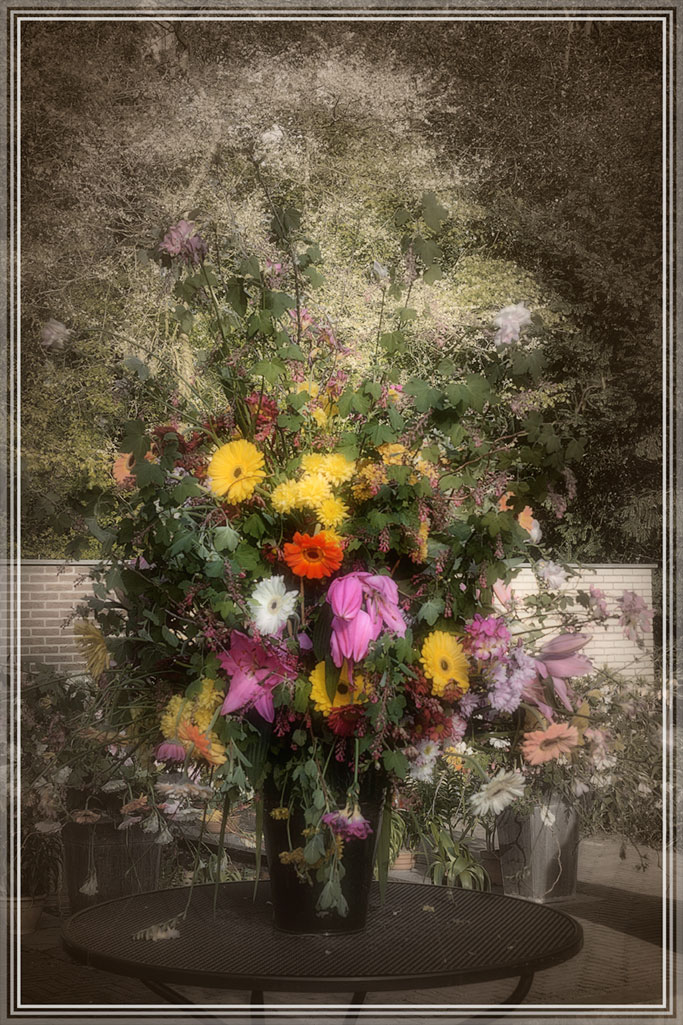A floral bouquet

Originally posted at - http://blog.aromyth.nl/?p=227
Florals seems to be the most popular family within the world of
perfumes. It embraces a huge group of fragrances with floral notes as a
main theme. Whether it’s a smell of a single flower or a complex
bouquet, an aroma of an existent flower, its abstract interpretation or a
perfumer’s floral fantasy. The huge majority of them are marketed as
feminine perfumes.
The H&R Genealogy of Perfumes places the entire floral family in the feminine section and makes the following subdivisions: Floral Green, Floral Fruity, Floral Fresh, Floral Floral, Floral Aldehydic and Floral Sweet. In the masculine section there was a separate group of Lavender perfumes as the only masculine floral. Later it was replaced under Fougères. The modern Symrise Genealogy recognizes much more subcategories under the floral family: Floral Citrus, Floral Aqueous, Floral Green, Floral Fruity, Floral Aldehydic, Floral Spicy, Floral Floral, Floral White Flower, Floral Orange Flower, Floral Woody, Floral Edible, Floral Musky. Florals also got a permanent place within the masculine section with two subcategories: Floral Green and Floral Woody.
The SFP classification (official perfumes classification by the Society of French Perfumers) divided florals into seven groups: florals soliflore (B1), florals lavender soliflore (B2), floral bouquet (B3), green florals (B4), aldehydic florals (B5), woody florals (B6) and woody fruity florals (B7). The newest version of this classification has a slightly different subdivision:
B1 – Soliflore with the smell of a single flower as the main theme. This subgroup refers to the beginning of the modern perfumery when the perfumers started to reconstruct the smell of flowers so they become more stylized and abstract.
Examples: Diorissimo by Dior (lily of the valley), A la Nuit by Serge Lutens (jasmine), Fracas by Piguet (tuberose)
B2 – Musky Florals with the central floral accord accompanied with the musky note presented from the beginning. May be accentuated with fruity, woody or aldehydic notes.
Examples: Musc Koublaï Khan by Serge Lutens, Pure Poison by Dior, For Her Musc Collection by Narciso Rodrigquez
B3 – Floral Bouquet with a complex harmony of different flowers combined into a bouquet.
Examples: Quelques Fleurs by Houbigant, Eternity by Calvin Klein, Elie Saab Le Parfum.
B4 – Aldehydic Florals – a combination of a floral bouquet with aldehydes that gives a fantasy touch to floral heart, a sparkle in the top in combination with citrus notes and a powdery base, especially with iris. Mostly those are perfumes with a classic structure, warm base of woods and resins and an animalic touch. Read more about this group here.
Examples: Chanel N5, Arpège by Lanvin, First by Van Cleef & Arpels.
B5 – Green Florals. A fresh floral bouquet with a touch of green notes like galbanum, cut grass or herbs. Hyacinth with its prominent green nuance is often used as a part of a green floral bouquet. The fresh and green aspects of Lily of the Valley, Freesia, Gardenia, Narcissus, Blackcurrent, Violet Leaf may also be used.
Examples: Vent Vert by Balmain, Bas de Soie by Serge Lutens, Pleasures by Estée Lauder
B6 – Woody Flruity Florals. A fruity bouquet on a woody base with a touch of fruity notes like peach, apple, plum, apricot.
Examples: Iris Gris by Jacques Fath, Amazone by Hermès, Lady Million by Paco Rabanne
B7 – Woody Florals. A floral bouquet extended with a woody base, mostly with a powdery touch of resins and vanilla. With a classic citrus of herbaceous top.
Examples: Grey Flannel by Geoffrey Beene, Fahrenheit by Dior, Balmya by Balmain
B8 – Marine or Aquatic Florals. A newcomer from the early nineties where a floral accord is combined with aquatic notes.
Examples: Escape by Calvin Klein, L’Eau D’Issey by Issey Miyaki, Tommy Summer by Tommy Hilfiger
B9 – Fruity Florals. The popularity of fruity florals started to increase in the late nineties with an explosive growth in the last two deccenia. A floral bouquet with an unmistakable presence of a fruity note .
Examples: J’Adore by Dior, Burberry London, Bright Crystal by Versace
The Fragrance Wheel by Michael Edwards describes three floral groups: Floral, Floral Oriental (a combination of sweet spices and a floral bouquet based on heavy florals like tuberose and orange blossom) and Soft Floral (corresponds with floral aldehydic group, but also includes iris perfumes and musky florals). It has separate groups for Green, Fruity and Aquatic (Water) perfumes.
 AromaX 10 years ago
AromaX 10 years ago
 Franfan20 10 years ago
Franfan20 10 years ago

